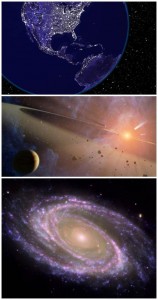In the next few posts I will lay out the case for starting up mining and industry in the solar system. Such an industry offers us brilliant possibilities; it offers to make us more secure here on planet Earth, to ramp up our economy, to create jobs, to pay off the national debt, to end poverty, to save the environment, and so on. And now you’re thinking I’m just another wild-eyed space enthusiast. But I haven’t even begun to show you what makes me really enthusiastic about space industry. None of the things I have mentioned so far is the Big Idea behind it.
Pop culture almost never talks about the value of space industry. Most people have never had someone explain to them the reasonableness of it. They are skeptical when you talk about mining the Moon or asteroids, or about building Martian colonies and things. It all seems too far away to be relevant. Exploration in space is something they do understand and value. Factories in space…not so much. They ask why we would want to dig for metal in an asteroid when there is still so much metal to be mined here on Earth. They ask how making things in space could be more cost-effective than making them on Earth where there are workers, resources, infrastructure, and consumers. These are good questions and deserve to be answered. And while there are actually a great many excellent reasons to start up space mining and industry, I am going straight to the most exciting reason of them all. (I will discuss those other reasons later, like abundant clean energy, and jobs, and national debt, and making our place more secure in this galaxy.) For now, I want to explain how our overall civilization can be revolutionized into something so awesome we are hardly able to imagine it. To have even a chance of imagining it, we first need to stretch our brains. Somehow, pop culture hasn’t stretched them for us.
So let’s start with the Russian astrophysicist Nikolai Kardashev (b. 1932). He was studying the possibility of radio signals from alien civilizations in space when he wisely noted that not every extraterrestrial civilization will be at the same level of progress that we are. Some civilizations could be vastly older than ours, and vastly far ahead — perhaps by hundreds of millions of years, or even by billions. When you consider that technology is growing exponentially (and possibly always has been), then a billion years’ head start really amounts to something. So Kardashev came up with a classification scheme for civilizations to help us stretch our brains. He defined a Type 1 civilization as one that is basically like ours. It’s what we assume a civilization is like when our brains aren’t stretched. Such a civilization has spread across its own planet so that it has brought essentially all the resources of the planet into its economic sphere. A Type 2 civilization, however, is one that has gone beyond its home planet and is using vastly more energy up to that of an entire star. A Type 3 civilization is one that has spread across interstellar space and has begin using the energy of all the stars in an entire galaxy. What Kardashev pointed out was that if there are any Type 2 or Type 3 civilizations out there, then their communications signals certainly would not look the same as our own.

Type 1, 2, and 3 civilizations are defined as planet-scale, solar system-scale, and galaxy-scale, respectively.
This begins to stretch our brains, which is important. Consider now our (already) more expansive way of thinking about alien civilizations compared to what we see in the popular movies of Hollywood. In the movies, the aliens are always smarter than us…well, they are about 2 or 3 times smarter than us. (And actually, they usually prove to be stupider than us in the end when they self-destruct.) Why is it that they are never portrayed as a hundred times smarter than us, or a thousand times, or a million times, or a billion, or a trillion? Is 2 or 3 times our intelligence some kind of natural limit? The problem is that the movie aliens suffer from a severe case of anthropocentrism, the assumption that the current state of humanity is the measure of all things, and so the aliens show up looking and acting basically like us. They are just a little smarter, more bald, and packing ray guns. What Kardashev did was expose the error that leads to anthropocentric movie aliens. He told us that there are so many orders of magnitude in the realm of what is possible — and we can apply this not just to the energy usage of a civilization, but to its intelligence, to its technological prowess, and to its depth of ethical commitment — that we shouldn’t assume our own civilization is the measure of normal. How could it be? We are still growing, at least technologically, and that so very quickly, so of course we haven’t discovered the limit of what is possible for a civilization. We haven’t even comprehended its order of magnitude.
And so this begins to hint at the Big Idea behind space industry. It’s not just about bringing back some metal we dug out of an asteroid. It’s not just about creating jobs or paying down the national debt. Those things will happen when we get space industry going, but the really mind-stretching outcome, the Big Idea, is the one that excites me the most. It’s the fact that space industry will put us well on our way toward achieving a Type 2 civilization with all the amazing things that that such a revolution will bring. As I will argue in future posts, we can achieve this outcome in as little as 50 years, and when we do — well, it’s almost impossible to describe what great things can follow.
In the next post, we’ll take a look at the revolutions of civilization that humanity has already gone through. I hope this will further stretch our brains and also encourage us, knowing that as we have done great things before, so we can do great things again. The current state of humanity is not the measure of normal. Talk of industry in space is not something to be skeptical about.
If you find this discussion interesting, please share it with your friends!
